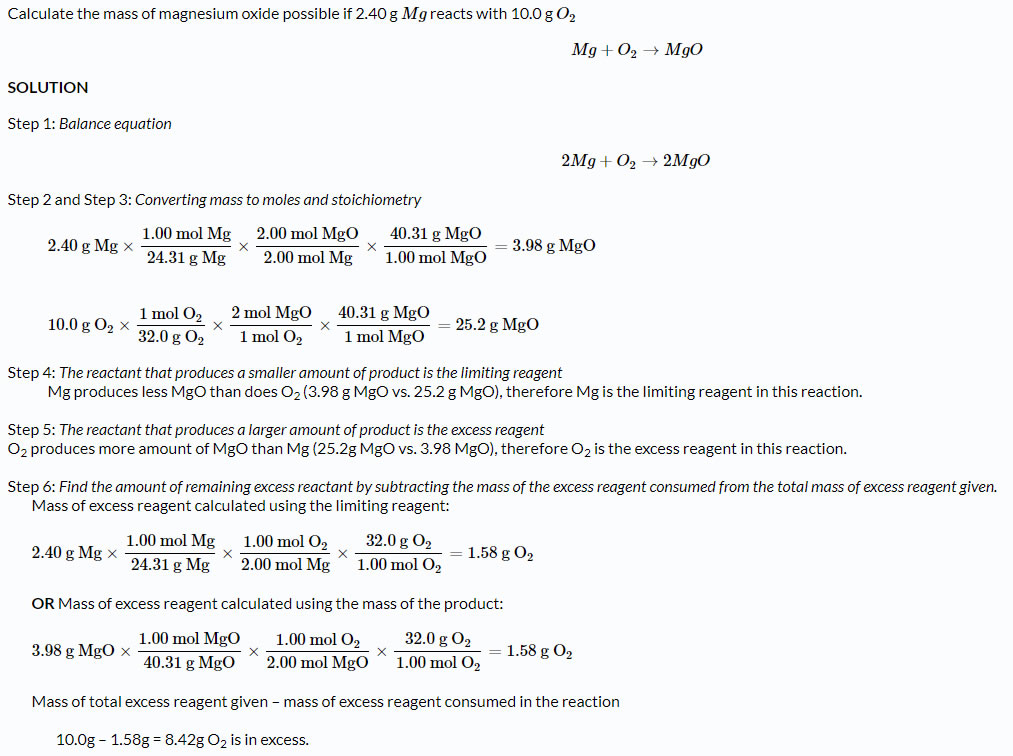Stoichiometry
The content that follows is the substance of lecture 14. In this lecture we cover the use of balanced chemical equations to make mole and mass predictions in reaction.
The Balanced Reaction
Reaction stoichiometry is a fancy way of describing mole relations in a reaction. When we read a balanced equation we relate every compound in the reaction to the others by means of the mole coefficients in the reaction.
For example: HCl + NaOH → NaCl + H2O
This equation is all 1:1 relationships, 1 mole of NaCl is made for every 1 mole of HCl or NaOH etc.
In a previous lecture I introduced the following analogy:
What can we do with a balanced equation?
A chemical reaction equation is essentially a table of conversion factors that we can use to predict amounts of products that can be made, reactants needed to make a specific amount of product or exact amounts of reactants needed to completely consume another reactant (eg. acid and base neutralization).
While the use of the stoichiometry (fancy words for mole relationships in a reaction equation) may seem difficult, it really isn't. Let's use an example that you all can understand first:
1 slice bologna + 2 slices of bread → 1 Sandwich
If I asked you how many sandwiches you could make with 12 slices of bread, you would immediately say 6, right? How did you know this? Well, obviously based on the equation, you make 1 sandwich for every 2 slices of bread you have.
12 slices bread x 1 sandwich/2 slices bread = 6 sandwiches
If I asked you how many slices of bologna and bread you need to create 10 sandwiches, you would immediately say 10 slices of bolgna and 20 slices of bread, right? Again the relationship given in the equation tells you how much is needed.
10 sandwiches x 1 slice bologna/1 sandwich = 10 slices bologna
and
10 sandwiches x 2 slices bread/1 sandwich = 20 slices bread
Finally if I asked you how many sandwiches you could make with 5 slices of bologna and 8 slices of bread? Which of the two sandwich makings would run out first and how much of the excess makings would be left over? Well, the answers are 4 sandwiches could be made and 1 slice of bologna is left over.
5 slices of bologna x 1 sandwich/1 slice bologna = 5 sandwiches
8 slices bread x 1 sandwich/2 slices bread = 4 sandwiches
8 slices bread x 1 slice bologna/2 slices bread = 4 slices of bologna used
5 slices bologna - 4 slices used = 1 slice left over
The process outlined above is the process you would use to answer stoichiometric questions on a test. The only difference is we need to work in the unit of moles rather that slices and sandwiches.
Here is a similar example:

The process for solving these problems is similar each time:
1) Write the balanced chemical equation
2) Convert what you are given into moles
3) Use the mole ratios in the balanced equation to determine the moles of whatever is needed (amount of product possible, amount of reactant needed etc.)
4) Convert the moles you calculated into the units requested e.g. grams or mL.
Here is another example using mL and M rather than grams:
Find the limiting reagent and the reactant in excess when 100 mL of 0.2M NaOH reacts completely with 50 mL of 0.5M H2SO4 solution.
Step 1: Write the balanced chemical equation for the chemical reaction:
2NaOH(aq) + H2SO4 (aq) → Na2SO4 (aq) + 2H2O(l)
Step 2: Calculate the available moles of each reactant in the chemical reaction:
Moles (NaOH) = 0.2M x 0.1L = 0.02 mol
Moles(H2SO4) = 0.5M *.05L L= 0.025 mol
Step 3: Use the balanced chemical equation to determine the mole ratio of the reactants in the chemical reaction to the product you wish to make:
0.02 mol NaOH x 1 mol Na2SO4/2 mol NaOH = 0.01 mol Na2SO4
0.025 mol H2SO4 x 1 mol Na2SO4/1 mol H2SO4 = 0.025 mol Na2SO4
The limiting reagent is the reactant that will produce less product in the reaction.
There will be some moles of the reactant in excess left over after the reaction has gone to completion. The limiting reagent is NaOH, all of the 0.02 moles of NaOH will be used up when this reaction goes to completion. The reactant in excess is H2SO4, when the reaction has gone to completion there will be 0.025 - 0.01 = 0.015 moles of H2SO4left over.